Household cappuccinators (milk frothers) are simple devices designed to automatically produce cold or hot milk foam. The most obvious use of cappuccino makers is to prepare coffee-based milk drinks. However, this device is also able to cope with other similar tasks – for example, preparing hot cocoa or mixing and heating a simple sauce.
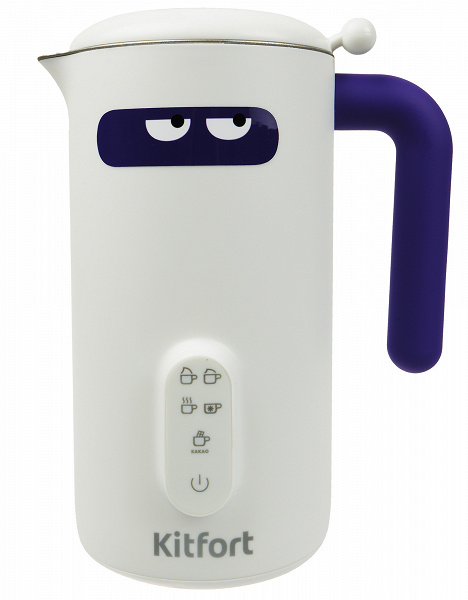
The first hero of our today’s review – the Kitfort KT-774 cappuccinatore – has built-in programs for all these cases. Let’s see how he copes with the tasks.
Well, in order not to start talking about cappuccinators twice, we decided at the same time to tell you about a similar model – Kitfort KT-775, which differs only in appearance.

Characteristics
| Manufacturer | kitfort |
|---|---|
| Model | KT-774-1 |
| Type | cappuccinatore (milk frother) |
| Country of Origin | China |
| Warranty | 1 year |
| Service life * | 2 years |
| Housing material | plastic |
| Case color | white, purple (model KT-774-1), there are also other color options |
| Control | electronic |
| Working temperature | 65°C |
| Heat | up to 500 ml |
| Heating and foaming | up to 250 ml |
| Power | 500 W |
| The weight | 0.9 kg |
| Dimensions (W×H×D) | 170×120×210 mm |
| Network cable length | 0.8 m |
| Retail offers |
| Manufacturer | kitfort |
|---|---|
| Model | KT-775 |
| Type | cappuccinatore (milk frother) |
| Country of Origin | China |
| Warranty | 1 year |
| Service life * | 2 years |
| Housing material | plastic |
| Case color | white |
| Control | electronic |
| Working temperature | 65°C |
| Heat | up to 500 ml |
| Heating and foaming | up to 250 ml |
| Power | 500 W |
| The weight | 0.9 kg |
| Dimensions (W×H×D) | 170×120×210 mm |
| Network cable length | 0.8 m |
| Retail offers |
* Contrary to common misconception, this is not the period after which the device will definitely break. However, after the expiration of this period, the manufacturer ceases to bear any responsibility for its operable
Equipment
Both devices are delivered in compact cardboard boxes designed in the Kitfort corporate style: on a black background we see a vector image of a cappuccinatore, on the side faces you can read about the main technical characteristics of the device and its key advantages – non-stick coating, five operating modes, stylish design and heating.

The contents of the boxes were protected from shock with foam inserts and plastic bags.

The equipment for both models was identical.
Opening the box, inside we found:
- cappuccinatore itself (with lid and whisk attachment)
- power wire
- instructions
- collectible magnet and promotional materials
At first sight
Let’s start our acquaintance with the KT-774-1 model. The device makes a nice, sweet impression. The main reasons for this are delicate colors, matte plastic and a sticker with eyes that “humanizes” the device (by the way, it can be easily peeled off and glued to another place). Let’s take a closer look at the cappuccinatore.
The case of the device is made of white matte plastic. The handle is also plastic, but purple. Plastic looks stylish and high quality. Fingerprints are not visible on it.
On the front side of the case, we see a sticker with eyes. Below are the control panel and the Kitfort logo.
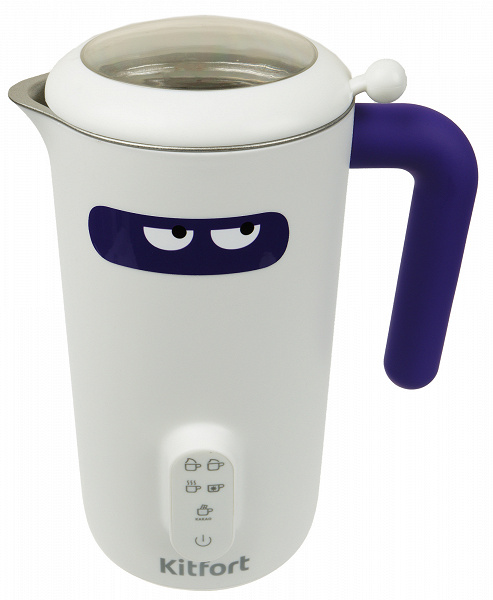
On the back there is a rubber plug that covers the connector for connecting the power cord. We hope that it will last a long time: after all, you will have to connect and disconnect the cord during operation quite often.
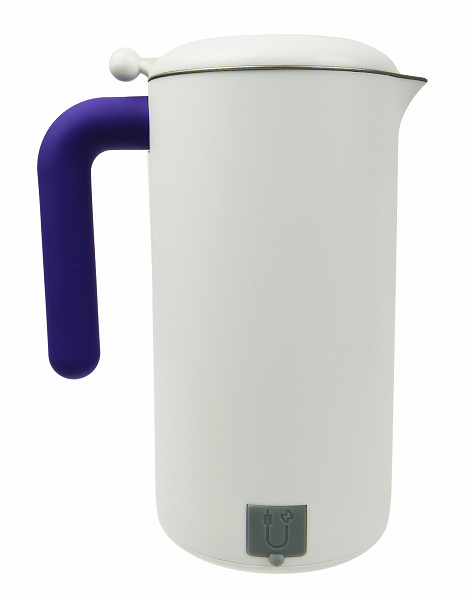
The 0.9 meter long power cord itself has an IEC 60320 plug, also known by the informal name “Mickey Mouse” due to its shape. Not the most popular solution in our country: such connectors can often be found not in household appliances, but in computer equipment. For example, laptops or monitors.
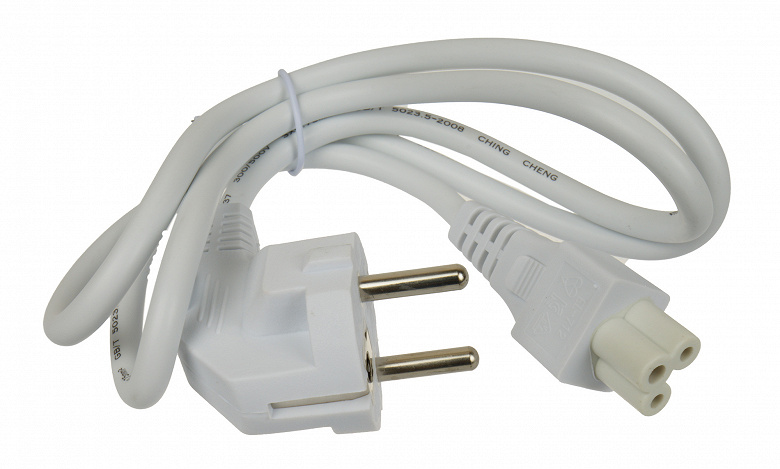
At the bottom of the device we see a sticker with technical information, rubber feet that prevent slipping, and a warning that the cappuccinatore cannot be immersed in water.

From above, our cappuccinatore is closed with a lid. Also noteworthy is the spout, which helps to pour the contents of the device into the cup.

The lid is plastic, with a transparent window through which you can observe the cooking process. On the side of the lid there is a handle, on the bottom there is a rubber gasket-seal.

I must say that the cover is installed in its place without any effort: the rubber gasket does not “hold” the cover and does not interfere with removing or installing it.

Finally, let’s look under the lid. Here we will see a metal case with a non-stick coating and a whipping nozzle, which is installed at the bottom, in the center.
On the side walls of the case there are marks corresponding to the minimum and maximum volume of milk. At the same time, there are two Max marks: the lower one corresponds to heating milk with whipping, and the upper one corresponds to just heating.

Inside the case, obviously, there is a small electric motor that rotates the nozzle.
The nozzle itself has a classic “spring” shape and is equipped with a miniature handle, with which it can be easily removed and put back after cleaning.
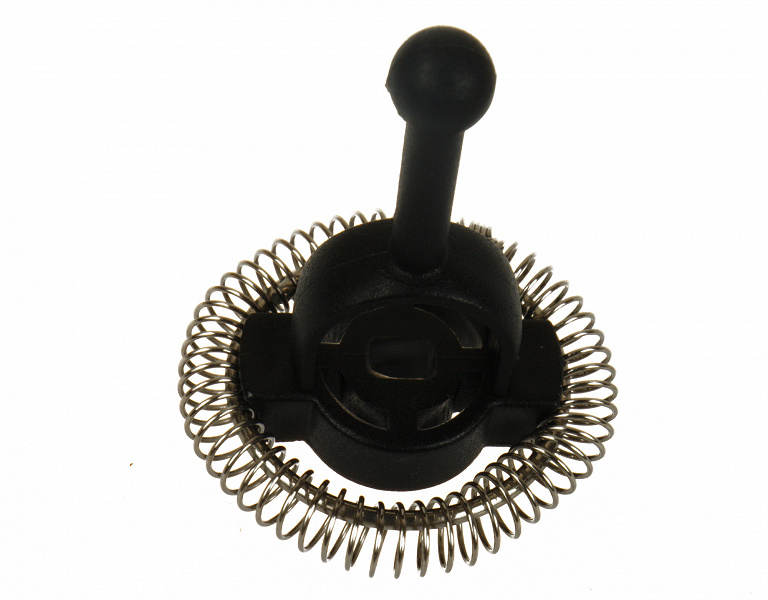
The rotation is transmitted directly (without the use of magnets), which means that there is a hole in the bottom of our cappuccinatore that can cause a potential leak. Of course, we hope that this will not happen, but it is almost impossible to predict this in advance.
Now let’s move on to the KT-775 model. Before us appeared exactly the same plastic “jug” with a control panel, handle and lid.

The connector for connecting the wire turned out to be exactly the same as that of the KT-774-1.

We did not find any differences either at the bottom of the device or in the control panel.
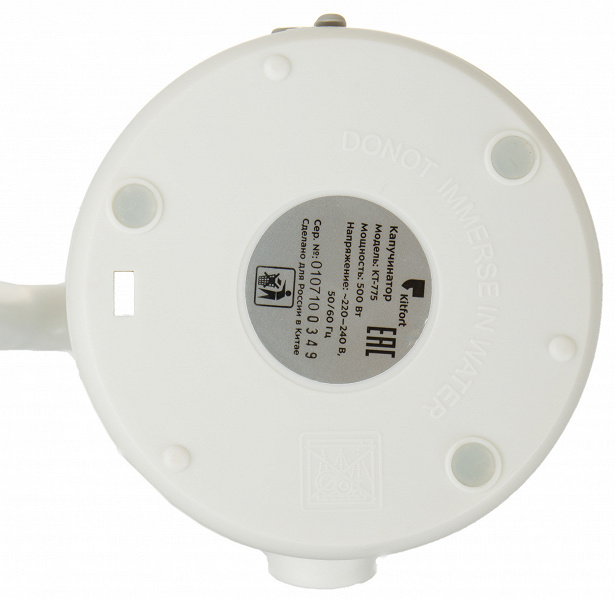

The inner walls were covered with exactly the same non-stick coating.

And the exact same spring nozzle is put on the central axis.

Perhaps, only the appearance of the handle and the lid differ here: in the 775th model it is also transparent and has a rubber sealing ring, but it “sits” in its place a little more tightly (which we liked more).
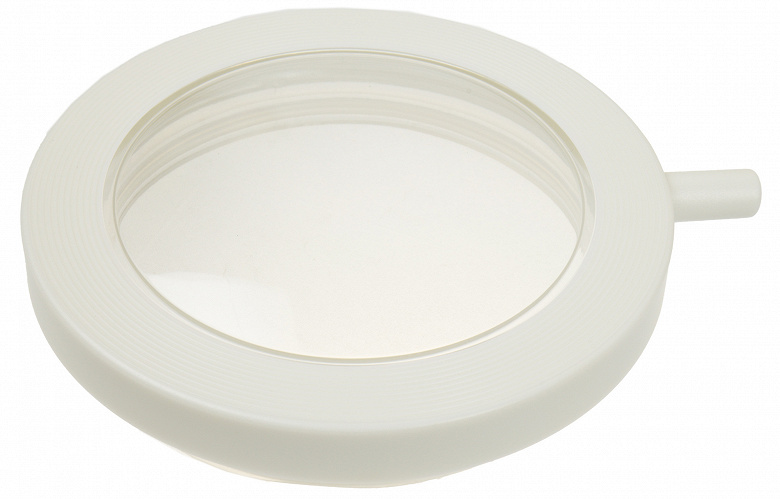
Having examined both devices, we confirmed our initial guess: we have two identical cappuccinators in front of us, differing only in appearance. All further discussions about the devices, the quality of work and the result of foaming will apply equally to each of the models. Looking ahead, let’s say that the operation of programs, temperature conditions and other measurable parameters for both cappuccinators also turned out to be the same.
Instruction
The user manual is a black and white A5 brochure printed on high quality glossy paper.
The user is invited to study one and a half dozen pages, on which he will find all the necessary information regarding the use of the device and its care.
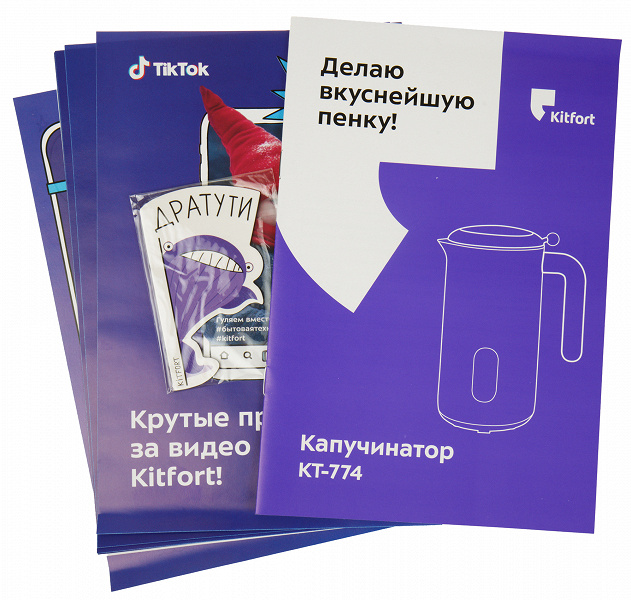

In addition to the necessary information, the compilers of the instructions included optional tips and interesting facts in the brochure that will help you choose milk for frothing, tell you how to prepare coffee drinks with milk foam, etc.
We traditionally like instructions from Kitfort: they are easy and pleasant to read. The compilers do not “strangle” the user with clericalism and entertain as much as they can.
In addition to the instructions, there were a lot of flyers in the kit offering to participate in advertising Kitfort products – write a review, shoot a video review, and so on. For participation in such activities, you can get prizes and gifts.
Control
The control panels of both devices were completely identical.
The only control of the device is the power button (it is also the mode change button), which you have to press from one to five times (depending on which program you want to run).
To turn on the device, you need to press the power button and hold it for three seconds. The indicator in the button will start flashing.

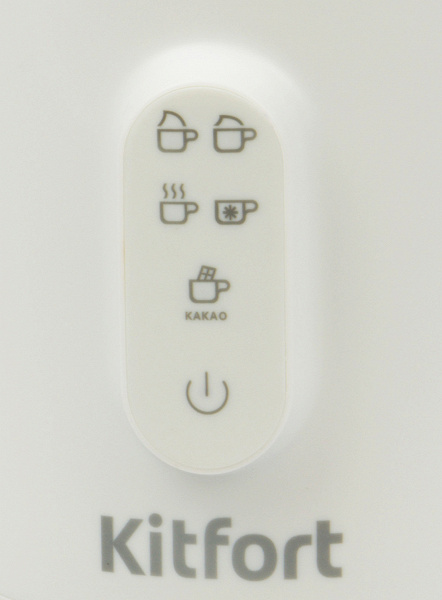
The programs are as follows:
- air foam with heating – for cappuccino, volume from 100 to 250 ml
- dense foam with heating – for cappuccino and latte art, volume from 100 to 250 ml
- heating mixing – mixing and heating sauces, volume from 100 to 500 ml
- frothing without heating – cold foam for coffee glasse, volume from 100 to 250 ml
- cocoa – hot cocoa, volume from 100 to 500 ml

Exploitation
Before the first use, the cappuccinatore must be washed and wiped dry.
To start using, you need to install the device on a flat surface, and also install the foaming nozzle on the axis at the bottom of the cappuccinatore. Then you need to pour milk, not exceeding the recommended amount for the selected program (otherwise the milk will overflow), connect the device to the power supply, put on the lid and select the desired mode.
The appliance will automatically turn off when the program ends. Since the cappuccinatore “knows” when to stop working with the help of the temperature sensor (that is, when the contents have reached the desired temperature), after each operation it must be allowed to cool down for at least three minutes. If this is not done, the device may turn off ahead of time.
During operation, the device makes a barely audible noise. Heating (if it is implied in the selected program) does not occur constantly: the cappuccinatore turns off the heating element from time to time to prevent the milk from burning on the bottom of the jug. However, the device failed to completely get rid of this problem: a small milky crust still forms in some modes.
Care
The body of the device may be cleaned with a dry or damp cloth. The nozzle and lid can be washed under running water, do not use the dishwasher.
The inside of the cappuccinatore can be washed with soap or dishwashing detergent, after which you need to rinse the container with water and wipe dry. Do not use harsh washcloths or abrasive cleaners as they may scratch the non-stick coating.
The body of the device must not be immersed in water or under a stream of water: the ingress of liquid into the body can lead to damage to the device.
The sealing ring on the cover is removable: it needs to be removed and washed from time to time.
Our experience has shown that the maintenance of the device does not cause great difficulties. A small amount of milk sticks to the walls of the container (or at the bottom – especially with prolonged heating), but is easily cleaned with a regular sponge. On the nozzle-foamer sometimes there is a sticky milk foam, which, again, is easily washed off with running water. We prepared several coffee drinks with milk in a row, and did not feel any discomfort.

Our measurements
During testing, we took several measurements to understand how long it would take the device to perform standard tasks. For tests, we took chilled milk straight from the refrigerator (this is the milk that is best for frothing).
It turned out that the energy consumption of the device is minimal – the motor consumes no more than 4 W, and the device spends less than 0.1 kWh of electricity to prepare (froth) one portion of milk (up to 500 ml), which we consider insignificant.
The temperature of the milk in the bowl at the time the heating is turned off, according to our measurements, is up to 67 ° C in the “cocoa” mode and about 64 ° C when milk is frothed.
The maximum power consumption of the device was 475 W, which almost exactly corresponds to the declared power.
practice tests
During testing, we checked various modes of operation of the device and evaluated the final result.
What should be the milk
Just in case, we recall that not every milk is suitable for whipping and not every one will give high-quality milk foam. We list the main criteria for choosing the right type of milk:
- milk should be whole, natural pasteurized, and even better – ultra-pasteurized – it whips best
- milk does not need to be boiled
- the quality of the foam depends primarily on the protein content, its increased content makes the foam viscous, creamy and microdispersed, so our choice is milk with a protein content of 3% or more
- but the fat content does not affect the formation of foam too much (but the taste, density and how long the foam stays depend on the fat content) – it is believed that it is better to use fat milk from 3% or more for cappuccino, and for latte or latte macchiato milk with a fat content of 1.5% -2.5%
- the temperature of the milk should not exceed 2-6 ° C, if the milk is warmer, then it will be whipped worse
For tests, we armed ourselves with milk with a fat content of 3.5% and a protein content of 3%. This is a pretty good option available, so we initially expected the result to be “good” or “excellent”.
Our test dishes turned out to be not quite coffee, but with their help we were able to assess the volume of foam and its quality “in the context”. To evaluate the volume of foam, we added freshly brewed espresso to the finished milk foam. Thanks to this, it was possible to visually assess how much foam was in the glass, and how much was unwhipped milk.
Cocoa
To prepare cocoa, we took 500 ml of milk (from the refrigerator), added three tablespoons of cocoa and started the cooking process without stirring the cocoa by hand.

At first, in the cappuccinatore, we observed large pieces of cocoa stuck together.

Then they became smaller.

…and even less (and more bubbles).

Finally, after 7 minutes and 48 seconds, we got a finished drink with a temperature of 67 °C. We did not find unmixed particles and lumps in it.

Result: excellent.
cold foam
The second test is cold foam (foaming without heating). This time, the maximum allowable volume of milk was 250 ml.
At first, foaming was not very effective.

However, soon the volume of foam began to increase.

After 2 minutes and 30 seconds, we got the perfect thick and evenly whipped milk foam.

Look nice! And yes, it tastes great.

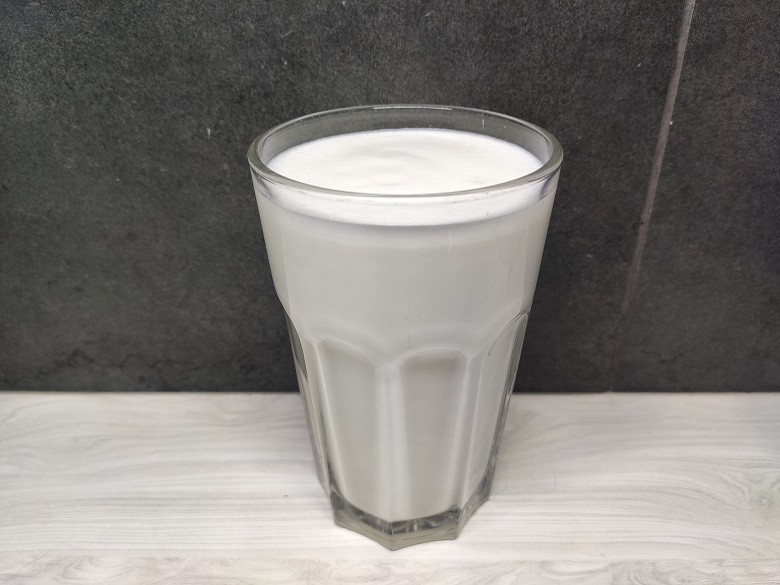
Result: excellent.
Heated dense foam
On the program, which was called “dense foam with heating” by the developer, we can whip up to 250 ml of milk.
It turned out that the cappuccino machine spends 3 minutes and 40-50 seconds to complete the program, while heating the milk to 64 ° C.
The result, however, did not impress us too much.
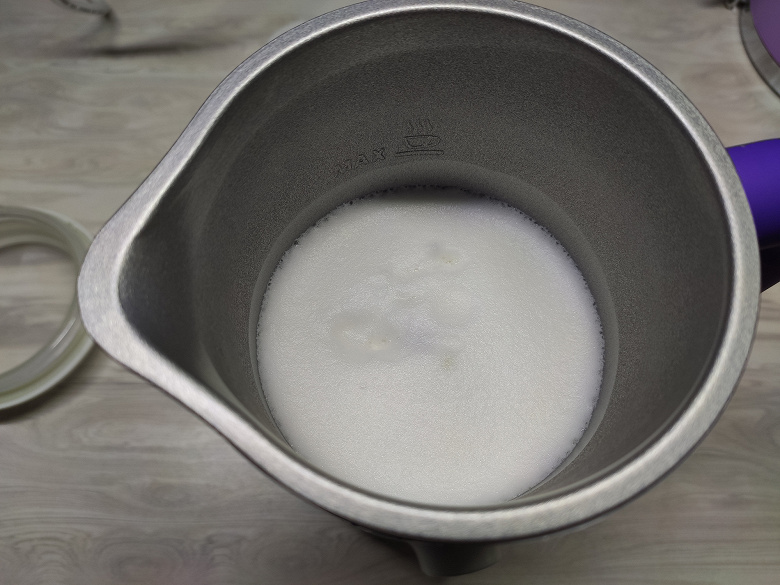
The amount of foam turned out to be small, and most of the container was occupied by warmed and barely foamed milk.
This becomes clearly visible after adding espresso.

We even repeated the experiment to make sure everything was going right.

The result was about the same.
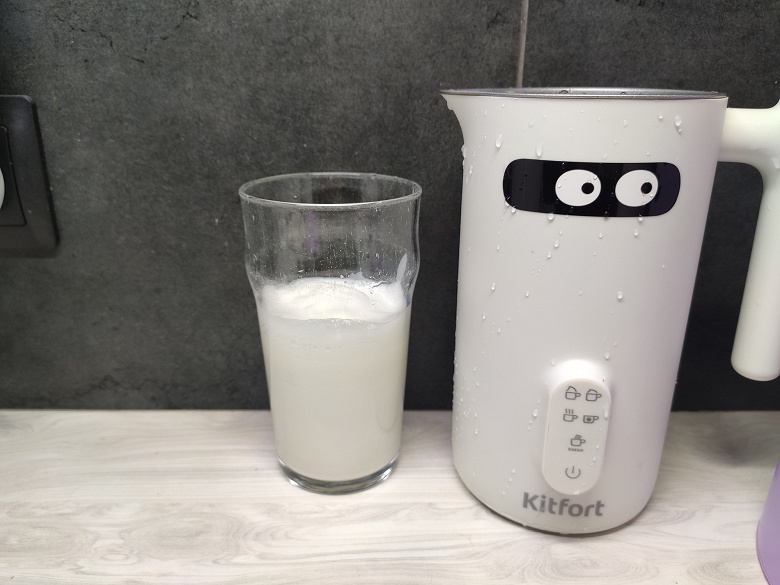
Little foam, hot milk – a lot.

The reason was also found quickly: it turned out that in this mode the cappuccino machine rotates the nozzle at a reduced speed. Well, judging by the fact that the icon of this program depicts a small “cap” of milk foam, this mode should rather be called “a small amount of foam with milk heating”. So, in our opinion, it would be more correct.
Result: medium.
Heated foam
Finally, the thing for which everything was originally started. How well will our milk frothers do with heated, thick foam?
We poured 250 ml of cold milk into a container, started the first mode and waited. The Cappuccinatore began to rotate the nozzle at maximum speed. The running time of the program was 3 minutes and 50 seconds, after which we got the thickest milk foam. A little more – and it could be bitten off.

This is what it looks like in a glass.
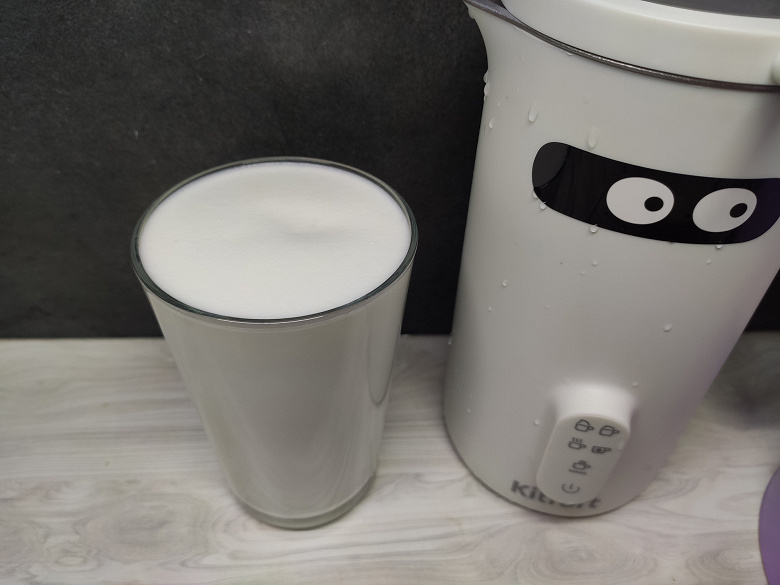
And here it is after adding espresso.

As we can see, the foam occupies almost the entire volume of the glass, keeps confidently and does not fall off for a long time.

Result: excellent.
findings
The Kitfort KT-774-1 and Kitfort KT-775 cappuccinators made an excellent impression on us and did not disappoint during practical testing. With the help of such devices, you can literally get hot or cold foam, as well as warmed milk and cocoa in just a few button presses. Maintenance of the devices was also easy: cleaning of both cappuccinators is equally easy, simple and effortless.


Among the shortcomings, we note the absence of a second nozzle designed specifically for mixing the contents without beating it. In our case, mixing is carried out using a whisker rotating at a lower speed.
The solution with a plug-in power cord, we can find both convenient and not. On the one hand, this method of connecting the device allows you to abandon the “base” (as with conventional electric kettles). On the other hand, let’s not forget that you will have to rinse the cappuccinatore after each use, and therefore, after each preparation of milk foam, you will have to pull out the cord, and after cleaning the device, insert it back.
Pros :
- stylish design
- several operating modes
- low power consumption
Cons :
- no mixing paddle without foaming




